
MANITOBA

Winnipeg Beach
NO PART OF THE FOLLOWING
ARTICLE AND PHOTOGRAPHS
MAY BE REPRODUCED WITHOUT
PERMISSION FROM THE AUTHOR ©
The property that would become Winnipeg Beach Park was owned by The Canadian Pacific Railway. It leased land to private developers. They in turn developed beach and picnic facilities. The railway then made additional profits by running passenger trains into the area, one of which was known as the "Moonlight Special". (See the advertisement farther on.)
The Trains
Circa 1910s
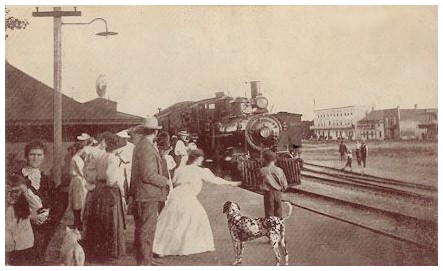 Notice the woman leaning toward the boy near the tracks. Her body language makes it appear that she is about to pull him farther back from the locomotive's path. |
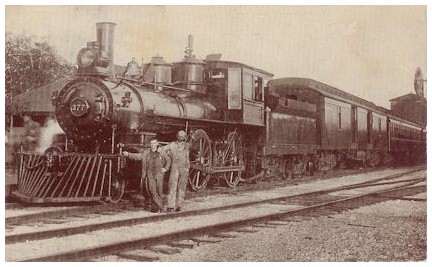
CPR Locomotive #377 was one of those that serviced the park. Note the windmill seen at Upper Right and in the previous photo. It may have been used to draw water from a well or possibly to generate power. |
The park came about because the CPR president, William Whyte, liked to boat on Lake Winnipeg around the turn of the 20th century. He thought that a particular sandy area on the shore would make a good amusement zone, and reasoned that, as with the urban trolley parks, fun-seekers would travel his railway to get to such an amusement area. In 1901, (1900 from another source) he and two others arranged the purchase for $1000 of a 13-hectare area of a farm owned by Donald Arquet. Whyte then had the tracks extended from the Winnipeg line into the new beach resort, which would ultimately run for about 2 kilometres along the shore. The trip from Winnipeg to the resort was about 80 kilometres by rail, and originally cost 50 cents.
|
Park Entrance Circa 19-0s 
|
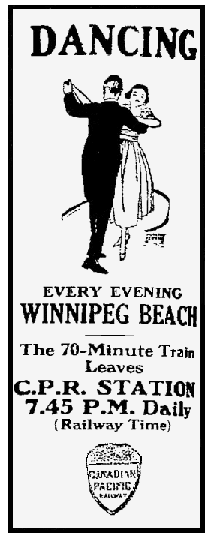 The Winnipeg Beach amusement area was ready to open for the 1902
season. Some of the first things installed were a rail station,
bathing facilities, and one or more unnamed rides. Refreshment and
lunch counters were included, and landscaping was done. In addition,
a dance hall was built that would entertain patrons until it was
replaced with a larger one in the mid 1920s. Its popularity must
have been high given that a later newspaper advertisement from
1919 (seen at the left) would proclaim "Dancing Every Evening".
The Winnipeg Beach amusement area was ready to open for the 1902
season. Some of the first things installed were a rail station,
bathing facilities, and one or more unnamed rides. Refreshment and
lunch counters were included, and landscaping was done. In addition,
a dance hall was built that would entertain patrons until it was
replaced with a larger one in the mid 1920s. Its popularity must
have been high given that a later newspaper advertisement from
1919 (seen at the left) would proclaim "Dancing Every Evening".
The park was supposedly electrically lit, but it's unclear if this was done from the start or not added until later. Apparently, it was not until later, because the carousel, installed in 1906, was run by a gasoline engine, and sources indicate that it was the addition of the first roller coaster in 1910 that may have signalled the beginning of electricity in the area. Even so, the streetlights continued to be coal oil or gasoline fuelled until 1930 when Manitoba Power ran lines to the area. That implies that any local electricity would have been generated on the spot before 1930, so the exact date of when the park first had electricity is in contention.
An addendum to this is that in one photo of a roller coaster (see farther on), there is a power pole with several transformers on it. Close to this is a building with what appears to be a tall, slim smoke stack. It may have been a steam plant which generated electricity to run the coaster and other rides. As well, next to this building is a windmill, which may also have been used to generate power. (Alternatively, it might have been used to pump water from a well.) The date on the photo is circa 1915 but that is wrong because the coaster shown was not built until 1919. Research on the park's electrical sources continues.
As the area grew in popularity, a rooming house and a hotel were built for 1903. The hotel opened as The King Edward. It would later be renamed The Beach Hotel, probably following a fire (1923 ?) when it was rebuilt of better materials. It apparently still stands today. Also constructed were some small stores, a restaurant, some snack bars, and a livery stable.
One of the first rides was a Herschell-Spillman carousel. It was a 3-row unit with 36 jumping horses and 4 chariots. The horses also apparently rocked. Built in 1904, the park received it in 1906, so it was either used or it sat at the factory for a year of so until Winnipeg Beach bought it. (The National Carousel Association believes it may have been in Louisville, Kentucky for those two years, but that is unconfirmed.) This ride would stay at the park until after World War I, when it was sold to Bowness Park in Calgary.
A general store was opened by one of the original three investors, William Robinson. He was a business owner in Selkirk, Manitoba. Food prices in that decade were typically the equivalents of: Butter - 6 to 9 cents per kilo, Eggs - 5 cents per dozen, Milk - 28 litres for $1.00 or about 4 cents when purchasing the equivalent of an individual litre. Fish - Pickerel for the equivalent of 4.4 cents per kilo and White Fish for 10 or 11 cents a kilo. Robinson's store, by then under new owners, would burn in 1944 and be replaced by a post office. This still exists.
In town was another hotel, The Waldorf, but it's not known at this time when it was built. The first school went up in 1907 as a single room.

|
Boaters Circa 19-0s |
|
Sailing Circa 19-0s |

|
In 1909, Winnipeg Beach had grown enough to achieve township status. It became official in 1910. In this and the following year, they improved the community with better sidewalks, a town hall, prison cells, and a water supply (via drilling more wells). Also by that year, a 175-metre breakwater had been built near Boundary Creek in an area known as Rocky Point. This sheltered the beach area from Lake Winnipeg. The park had become so popular that 12 to 15 trains a day ran 40,000 passengers to the park on holiday weekends. (Boundary Creek was, until 1912, the northern boundary of Manitoba, hence its name. That year the boundary was extended to North Latitude 60, Manitoba's northern border today.)
|
The Beach Circa 19-0s 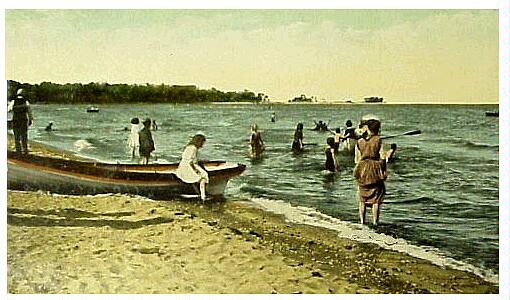 Swimmers and boaters enjoy the water at Winnipeg Beach a century ago. |
|
Spectators Circa 19-0s  Spectators Watch an Event from the Beach |
New Roller Coasters
A company called "Beach Attractions" was leasing property bounded by the Canadian Pacific railway station and the Lake Winnipeg shoreline to Stephenson's Point. They added a roller coaster to their concessions already in the area. It's not clear as to what coaster this was nor that it opened in 1910. It's my opinion that this was The "Dips" and this ride may have lasted until 1919 when a Miller & Jarvis "Giant" coaster opened.
The confusion comes from the fact that one reference states that The "Dips" and "Giant" were the same ride. This may have been because The "Giant" was referred to as "The New Dips" in photographs and probably by many park goers of the time. Since both had the word "dips", the confusion may have arisen there. Although it is not clear that this first coaster existed at all, most evidence points to them being separate rides. If this was the case, I don't know if The "Giant" replaced The "Dips" or if both ran concurrently for a time. Given that the park's boardwalk was extended to reach the new coaster, The "Giant" was likely built in a different location from the old "Dips".
It appears that the "Giant" name was not actually used, but may have been. Regardless, "New Dips" appears most often in reference to the ride. In addition, a reference to it being called "Jack Rabbit" during its life has also surfaced. However, this may have been confused with a coaster of that name at River Park.
Stan Barker, archivist at The National Amusement Park Historical Association, while researching The "Deep Dipper" coaster at River Park, came across something else. He says: "As a bonus, there's a blueprint drawing of another Winnipeg coaster, NOT by Miller. This is dated April 1925 and reads:
Profile and Key Plan of Roller Coaster
Winnipeg Beach, Manitoba
Drawn by J.W. Hawker / Architect
312 Kennedy Building
Winnipeg, Manitoba
Corrected by M. L. Taillon
Superintendent Construction
Haverhill Mass.
Stan continues: "This coaster was a double out and back of which some of the track criss-crossed in a long figure 8 style. Why it was in with the Miller material, I don't know. One guess: there are some pencil markings (numbers & lines) at positions on the blueprinted layout, so perhaps Miller was called in at some point to modify this coaster."
I have now obtained copies of the blueprints from Stan. Comparing it to photos of The "Giant", I'd say they are one in the same. Stan says his "Figure 8" comment above should not be taken to imply that this ride was a classic Ingersoll-style "Figure 8". Although at a first glance of the blueprints it appears to be such a model, it is a double out & back that happens to have the final return track cross under the first drop and two other track sections. Coupled with the fact it was higher and had deeper drops, it was not a "Figure 8" in the classic sense.
The layout was said to be 1,600 metres in length and runs as this: Out of the station into a long left-turning 180-degree curve to the lift hill. The lift and its drop are angled to cross diagonally left to the opposite side of the layout. It appears to be 20 metres tall with an 18-metre drop, sloping down at about a 28-degree angle. This is quite shallow, (see photo below) even for the time period.
After a small hill, the track curves up and into the first turn-around, which turns 180 degrees to the right. Down the other side, it climbs another hill, drops and then travels down a long, low-angle ramp and up to the second turn-around. Here it curves right to cross over the base of the lift hill where it completes a 180-degree turn near the station.
It drops and rises a few more times as it once again nears the far end of the layout and then curves right for the third turn-around. This one is lower and outside of the first turn-around and is banked. It travels about a third to half way down the layout where, near ground level, it moves sharply right to cross diagonally under the first return track, the first drop, and second outbound track so as to arrive back at the station.
A quick measurement shows that the 1600-metre figure was exaggerated. it appears to be less than 900 metres in length. However, the dips and turns might make up some of that. Recently discovered newspaper reports of the time state the lift hill height was the equivalent of 24.4 metres - another figure that seems too low if the ride was actually 1,600 metres in length. Another length figure given is the equivalent of 915 metres, a much more likely number. As well, the initial drop is stated to be 19 metres at 22 degrees. That calculates to a frictionless speed of about 70 km/h, far less than the 160 km/h claimed in the newspaper. Also reported is that the ride used over 91,000 metres of lumber and 12,000 bolts. Advertised prices were $40,000 and $45,000. There were four trains of three cars each which were built in Winnipeg.
|
Giant (New Dips)
Roller Coaster Circa 1920s  This gives a good overview of the new ride. The station is at the left with the ticket booth at the almost extreme Lower Left. Following the track from the station and through the foreground one comes to the lift hill. The building at the right may house an electrical generator. Note the power poles between it and the coaster structure. |
|
Giant (New Dips)
Roller Coaster Circa 1920s 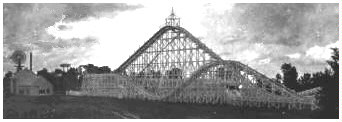
|
Provincial Archives of Manitoba photo (#36-N13304), erroneously dated 1915. |
| In this partial view of the coaster, the first drop descends to the right. Note its shallow angle. Moving away from you, the final return track passes through the structure at Center Bottom, right. |
Stan questions why these plans were in with other Miller items. He is not convinced the design was by John Miller: "As to it being by Miller & Jarvis... it may well be, but don't give too much weight to the fact that it was in with Miller material. I've also found a layout sketch for the Detroit "Bobs" in the Miller material... though it clearly says `Prior & Church' and bears Fred Church's signature!". One newspaper of the time only mentions Arthur Jarvis, so it may be that Miller was not involved.
Perhaps Miller was looking at modifying The "Giant" to make a version that would become the River Park coaster since both plans were together. To that end, maybe he commissioned a local Winnipeg architect to have measurements taken of the existing structure. This may be the case because the plan notes imply measurements were taken after construction. (See below.)
River Park was close enough (60 kilometres as the crow flies), that it would have been considered competition, and certainly Winnipeg Beach drew some of its patrons from the city of Winnipeg via direct train transport. River Park may have initially wanted a similar coaster with which to compete, but then decided to have Miller build a much larger one. That became The "Deep Dipper" in 1928. The problem here is that a competing park would be unlikely to allow such measurements to be taken. Also, The "Deep Dipper" was under 800 metres in length, not longer than The "Giant". One would think that a competing park would want a longer ride.
"Giant" Coaster Opening?
Until recently, the question was: When exactly did the Winnipeg coaster ride open?. On one side is information from some sources which said or implied 1919. Supporting that is a photo supposedly taken in 1920 and captioned "The New Dips Roller Coaster". More evidence for a 1919 opening comes from a comment that a general workers' strike that year delayed the time the ride was to open. One final report comes from Jim Abbate of Chicago. He found a reference to the ride being overhauled in 1924. I question as to whether this refers to the new ride. It seems strange that an overhaul was required on an only four-year old coaster. Maybe The "Dips" was still in service and it was the one to which the "overhaul" comment referred.
On the other side of this argument, is the *same* image which is dated by The Provincial Archives of Manitoba as "1927". (See photo below.) Add to this the blueprint date of 1925, and it seems that this coaster could have opened that year. A 1927 photo would be unlikely captioned as "New", six years after the opening of a 1919 ride. Then too, perhaps the Archives' date is wrong; their "1915" date was wrong. More evidence against a 1927 opening is an accident report for this ride dated "August 1st, 1925".
|
Giant (New Dips)
Roller Coaster 1927 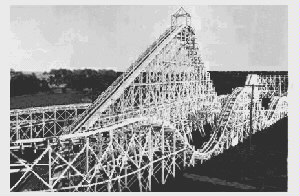 (Altered photo #21-N11748 Provincial Archives of Manitoba) |
This George Cripps photo shows the lift
(Center) and first drop heading away from
the viewer. It crosses over the layout to
the left side of the track seen in the
Center Right background. The foreground part of the structure is the first return leg, which comes from that right background track. (See next photo.) It passes the viewer and then curves left out of frame to the track at Center Left, which then runs out of sight to the right behind the lift hill. |
|
Giant (New Dips)
Roller Coaster Date Unknown  Here is a similar, but wider angle shot. Both this and the above were likely taken from what may have been the power generation building. Note the billboard at the left advertising a cafe. It was not in the first coaster photo, so this is likely a shot from later in time. |
|
Giant (New Dips)
Roller Coaster Date Unknown 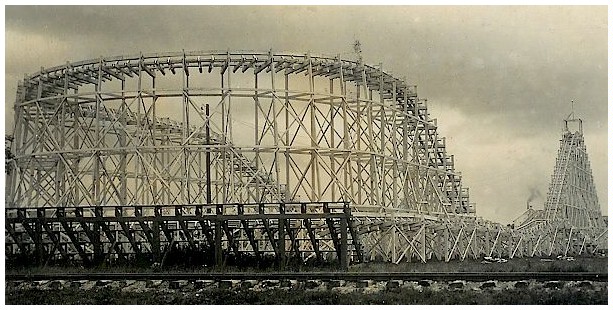 This shows the first and third turnarounds. The third is the lower banked track seen behind the bleachers facing the coaster structure. Did spectators sit here to watch the ride? It's awfully far from the ride's station. In the background is seen smoke coming from a stack - the building next to the coaster? If so, it's more evidence that this generated power for this ride and perhaps for usage elsewhere in the park. Also note what appears to be railroad track at ground level at the bottom of the photo. Was this end of the coaster near the rail line, or is it track for some other ride? |
A caveat regarding the blueprint is that one section of it has the statement "No measurements owing to struts and braces". That implies that the measurements could not be made due to impeding woodwork, and thus sounds as though they were taken after the coaster went up. That seems odd for a blueprint. Even if that was the case, why wait 6 years to make such a blueprint?
I must conclude that the plans were for a Miller ride, even with neither his name nor Jarvis' being on them. Despite Stan Barker's misgivings, it *was* in with Miller materials, and other sources say this was a Miller/Jarvis ride.
Date Update!
Victor Canfield of Hershey, Pennsylvania has located
a newspaper brochure, Vacation Suggestions, from
July 1919. It shows a photo of The "Giant" and states
that it is a new coaster about to open. So all the
contradictions have been pushed aside; it is clear now
that this ride opened Saturday, August, 2nd 1919.
Thank you, Victor!
|
Here is the first turn-around. The train
has just made the initial drop (out of frame,
left) and run up to the top of the track seen
at Upper Left. It is now dropping to navigate
the first return leg of the ride, as seen
in the foreground of some of the previous
photos. Note the fan-shaped support structure at Lower Left and Center Bottom. The foreground track at Lower Right is just after the final turn-around and before the track turns to run through the structure to cross the layout and enter the station. |
Giant (New Dips)
Roller Coaster 1946  (Altered photo #42 Provincial Archives of Manitoba) |
This ride would run from August 1919 until the park's closing in 1964, although one source says it continued to give rides for an additional two seasons through 1966. It would be demolished in 1967.
Only one accident on this coaster has turned up in research. Victor Canfield located an account that says a man was thrown from the coaster on August 1st, 1925. He had been standing at the time. There is no word on his injuries.
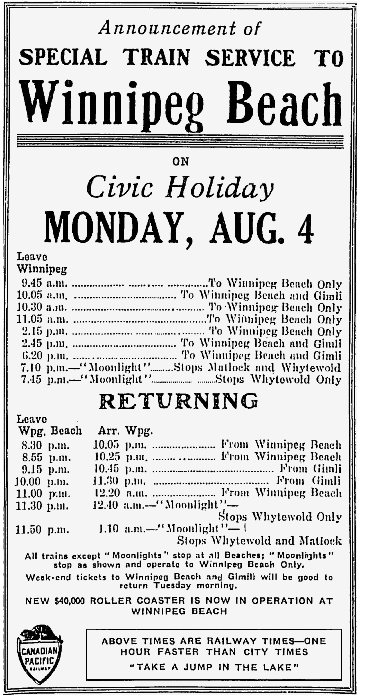 Getting back to the early days, jutting out from the beach was a
2.5 to 3-metre wide government pier that ran out for about 100
metres. It formed one of the boundaries of Winnipeg Beach Park, with
Stevenson's Point being the other. Although not mentioned, it may
have been built on the breakwater which had been constructed in 1910.
Part of the pier was covered. At its end was a navigation structure,
and later a popcorn stand. As well, at some point the pier was
replaced. Was the government wharf the new one, or was it the one
that was replaced?
Getting back to the early days, jutting out from the beach was a
2.5 to 3-metre wide government pier that ran out for about 100
metres. It formed one of the boundaries of Winnipeg Beach Park, with
Stevenson's Point being the other. Although not mentioned, it may
have been built on the breakwater which had been constructed in 1910.
Part of the pier was covered. At its end was a navigation structure,
and later a popcorn stand. As well, at some point the pier was
replaced. Was the government wharf the new one, or was it the one
that was replaced?
There were also smaller piers for the swimmers which were erected at the start of each season and then removed for the winter. Presumably, they were too lightly constructed to survive the winter storms and ice.
As may be seen in the 1919 advertisement at the left, the railway promoted the beach and ran extra trains on special days. As shown at the bottom of the ad in this instance, it also promoted the new roller coaster. Although not all of the rolling stock had arrived, the coaster had still opened two days earlier using what cars they had. Another news item stated that the official coaster opening was to occur at 3:30 PM that Saturday (August 2nd).
|
The Beach and Pier Circa 1890s through 1910s The new pier is seen in the second through fourth photos. Note the boat ramp to its left in the last photo of this group. |
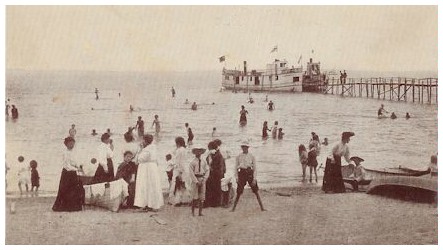
|
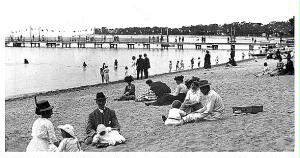
|

|

|
Cottages began to spring up in the area for those wishing to stay longer than just a day. Some were fairly elaborate with a common room used as a kitchen/dining area and as a living room, and two or more bedrooms. Others were winterised and became residences for the year-round citizens. By the mid 1950s, there would be 1500 cottages, cabins, and year-round residences.
 |
Waterslide Date Unknown |
The Canadian Pacific Railway Company moved their station and tracks away from the beach in 1911. The area had grown enough that they needed a larger rail yard. They also built The Empress Hotel near the beach area. It lasted until destroyed in a fire (1923 ?). Another one mentioned is The Lake Park Hotel on the corner of Park Avenue and Prospect, but its years of operation are not yet known.
|
The Empress Hotel Circa 1910s |

|

|
The park apparently replaced their carousel around 1919 or 20. It went to Bowness Park where it stayed until 1969. It currently resides at Heritage Park in Calgary. What replaced this unit is unknown, but the park did have a carousel at closing.
1923 saw a large fire in the town. It burned an area which included Murray Avenue to Robinson Store on Railway Street (later to be Main Street). Fortunately, it never crossed over to the beach area.
In 1924, a large two-story dance pavilion was constructed south of the first structure. (One source gives 1926.) It was rectangular with a dome pitch to the roof which rose to the height of a third story at the peak. Four turrets graced the corners with an additional six smaller turrets between the main ones along each long side. Flags flew from each. Along at least one side was a one-story section that extended out from the building. It went around the end and continued about one third of the way along the short side. On top of this section was an outdoor balcony. The dance floor covered 130 square metres and the opening band for this new hall was Peavey's Orchestra, which continued for that entire season.
|
The Dance Pavilion Date Unknown 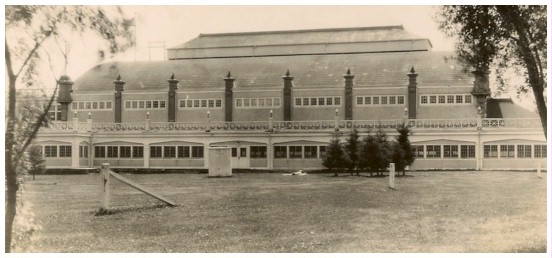
|
At one point, there was a suspended stage above the dance floor, but no additional details have yet surfaced. The original dance hall was used for various purposes initially as is evidenced by a report from July of 1927. The Winnipeg Sea Cadets were guests of Beach Attractions then and were served a supper in the old dance hall as part of the day's activities. The hall later became a hospital and was still apparently standing at the park's closing.
One of the later house bands at the new dance hall was Plant's Orchestra. The pavilion's heyday would end in 1953, with Bob Crosby's Band being the last major act to play there. The hall then was used as a roller rink and stood until being torn down at the park's demise. (Note that one source believes the dance hall was destroyed by fire in the 1950s. The confusion may be due to there being two dance halls at this park over the years.)
The amusement zone was located parallel to the main street of the village which eventually came to include a drug store, a hotel/beer parlour, two pinball arcades and a number of food outlets. These were on the opposite side of the street from the beach of which its concessions and boardwalk formed the businesses on that side of the street. The boardwalk in turn, was separated from the beach by a line of trees.
|
The Boardwalk Circa 1940s 
|
By the 1940s, along or near that boardwalk were 7 rides (including 2 kiddie), a dozen games, the dance pavilion, a penny arcade, shooting gallery, a pony track, and a theater. This theater apparently showed motion pictures, at least in its early days, along with live acts. There were five refreshment stands including cotton candy, popcorn, rainbow ice cream, and Kelly's - where french fries were the favourite. One of these concessions, likely a ride, was run by Frank Pratt. He had constructed buildings and a roller coaster at Winnipeg's River Park.
Rides and attractions mentioned, but not all documented as to when they were in the park, included a "Seaplane De Luxe" (Traver), a carousel, "Dodgem" (Bumper Cars), a Funhouse, kiddie boat ride, roller coaster, and a "Tilt-A-Whirl" (Sellner"). Games included a Duck Pond, Shooting Gallery, and a Colours Game where you picked a colour and rolled a ball down a ramp to try to get it to land on the colour chosen. The shooting gallery used 5.6mm (.22) rifles and offered candy as prizes. Bullets were 3 for 10 cents, or 9 for 25 cents.
|
This high-angle photo was taken from the
Giant roller coaster. Part of its
second turn-around is in the foreground.
At Lower Right is the station roof. Seen in the distance are the beach and wharves. The ride and structures at Center Left and Upper Left are unidentified, although the first ride at the left is a Seaplane De Luxe. |
The Rides Area Circa 1940s 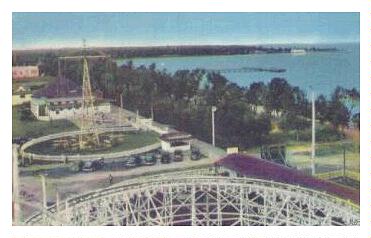
|
 Patricia Rigey, who spent her summers at the park, mentions a
third coaster. She was never able to go on the big coaster but was
able to ride the smaller one. It apparently was a junior steel
coaster made by Spillman and went to Chippewa Park in Thunder Bay
after Winnipeg Beach closed. Greg V.G. provides this description:
Patricia Rigey, who spent her summers at the park, mentions a
third coaster. She was never able to go on the big coaster but was
able to ride the smaller one. It apparently was a junior steel
coaster made by Spillman and went to Chippewa Park in Thunder Bay
after Winnipeg Beach closed. Greg V.G. provides this description:
"I have seen the Chippewa ride and it is more closely classified as a junior steel. The lift hill is approximately 10 metres tall and the ride negotiates a couple of hills before heading right going a ways to another turn sharply right, turning left, then heading back to the station. I believe that the manufacturer is Herschell-Spillman but am unable to independently confirm at this point. The ACE 1991 `Guide to Ride' says this ride was relocated to Thunder Bay."
CEC information shows that the Chippewa coaster was a used ride installed in 1967. That fits with the 1964 closing date of Winnipeg Beach, especially the fact that some rides supposedly stayed at the beach until 1966. So if this ride was one of those, it may have been sold that year to Chippewa Park and shipped there for the 1967 season. Research continues.
In 1960 The CPR, which had experienced declining rail travel since the end of World War II, ran its last train to the park on Labour Day. They had already begun to dispose of most of their holdings and no longer kept up the 13-hectare site, which had boasted good lighting, flower gardens, and a park warden. After CPR's bowing out, Beach Enterprises was unable or unwilling to maintain it, so it deteriorated. The owner, Harry Silverberg, was unable to get government assistance and the park closed by October 1964, although many items remained until 1967 when they were demolished. Note that several sources give the closing year as 1966. This contradiction may be because of the possibility that rides were run past the official park closing date for a season or two.
|
Giant
Roller Coaster During Demolition 1967  Photo by Jim Ablett Provincial Archives of Manitoba |
A dreary day matches the mood as the
park is demolished. Wood is stacked on
the coaster cars which still sit on
the track at Center Left. The curved track in the foreground is likely that of the small, steel Spillman coaster. |
The carousel endured; it was moved to Lakehead Park, although one source says it did not survive. I believe this confusion comes from the fact that the carousel building was destroyed. The demolition came about because the Province of Manitoba wished to develop a provincial park on the property, so they purchased it and removed the boardwalk & other remnants of the former Winnipeg Beach Park. $800,000 was spent to renovate the area, which opened July 29, 1968. It is now a day-use recreational site.
The only remnant of the park is a Vulcan Iron Works water tower. It was constructed in 1928 as a source of water for the steam locomotives of the time. It also served as a water source for protection of the park in case of fire. The tower, which was the most prominent feature at Winnipeg Beach Park, is 40 metres high and can hold 90,000 litres. It is currently not being used, having ceased usefulness when the park closed in 1964.
Since then, the boardwalk was realised to be a heritage item and was rebuilt, albeit without the rides. The Global Television movie, and then series, Falcon Beach was filmed and set in the town of Winnipeg Beach.
|
My thanks to Tim Covell of Ottawa, Ontario for information on
Winnipeg Beach and for usage of the coaster photos. Here are some other Winnipeg Beach, or related, websites:
|
Return to the
Closed Canadian Parks Index
Return to the
Closed Canadian Parks Introduction